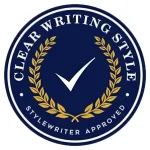Legal Writing – clear, precise writing or bad writers?
“Why do lawyers write so that no one can understand them? They say it is because they need to be precise and that their language has been honed by centuries of litigation. But this is baloney.
The real reason it that, although they are paid for their skill with words, most lawyers are dull and clumsy writers who have not broken the bad habits they have learned as students.”
Mark Adler – Author of Clarity for Lawyers
Example of Legal Writing
One test that is helpful in determining whether or not a person was negligent is to ask and answer whether or not, if a person of ordinary prudence had been in the same situation and possessed of the same knowledge, he would have foreseen or anticipated that someone might have been injured by or as a result of his action or inaction. If such a result from certain conduct would be foreseeable by a person of ordinary prudence with like knowledge and in like situation, and if the conduct reasonably could be avoidable, then not to avoid it would be negligence. To decide whether the defendant was negligent, there is a test you can use. Consider how a reasonably careful person would have acted in the same situation. To find the defendant negligent, you would have to answer “yes” to the following two questions: 1) Would a reasonably careful person have realized in advance that someone might be injured by the defendant’s conduct? 2) Could a reasonably careful person have avoided behaving as defendant did? If your answer to both of these questions is “yes,” then the defendant was negligent. You can use the same test in deciding whether the plaintiff was negligent.
Measure |
Score |
Rating |
Target |
| Words | 202 | ||
| Average Sentence | 22 | Fair | 13 to 18 |
| Passive Index | 22 | Fair | Up to 10 |
| Style Index | 108 | Bad | Up to 15 |
| Bog Index | 59 | Fair | Up to 15 |
| Reading Grade | 12 | Standard | Up to 10 |
| Jargon | 0% | Excellent | Up to 1% |
| Glue (Wordy) | 56% | Too Wordy | Up to 40% |
| Pep (interest and engagement) | 11 | Fair | Over 15 |
| Clarity Index | 15 | Bad | Over 80 |
Clearer
To decide whether the defendant was negligent, there is a test you can use. Consider how a reasonably careful person would have acted in the same situation. To find the defendant negligent, you would have to answer “yes” to the following two questions:
- Would a reasonably careful person have realized in advance that someone might be injured by the defendant’s conduct?
- Could a reasonably careful person have avoided behaving as the defendant did?
If your answer to both of these questions is “yes,” then the defendant was negligent. You can use the same test in deciding whether the plaintiff was negligent.
Measure |
Score |
Rating |
Target |
| Words | 101 | ||
| Average Sentence | 14 | Excellent | 13 to 18 |
| Passive Index | 14 | Good | Up to 10 |
| Style Index | 39 | Good | Up to 15 |
| Bog Index | 0 | Good | Up to 15 |
| Reading Grade | 8 | Easy | Up to 10 |
| Jargon | 0% | Excellent | Up to 1% |
| Glue (Wordy) | 51% | Too Wordy | Up to 40% |
| Pep (interest and engagement) | 7 | Poor | Over 15 |
| Clarity Index | 68 | Fair | Over 80 |
Edited With StyleWriter
To decide if the defendant was negligent, use this test. You must answer “yes” to both questions.
- Would a reasonable person realize the defendant’s conduct might injure someone?
- Would a reasonable person avoided behaving as the defendant did?
If your answer “yes” to both questions, then the defendant was negligent.
You can use the same test to decide if the plaintiff was negligent.
Measure |
Score |
Rating |
Target |
| Words | 63 | ||
| Average Sentence | 11 | Excellent | 13 to 18 |
| Passive Index | 0 | Excellent | Up to 10 |
| Style Index | 0 | Excellent | Up to 15 |
| Bog Index | 16 | Good | Up to 15 |
| Reading Grade | 7 | Easy | Up to 10 |
| Jargon | 0.00% | Excellent | Up to 1% |
| Glue (Wordy) | 46% | Wordy | Up to 40% |
| Pep (interest and engagement) | 12 | Fair | Over 15 |
| Clarity Index | 80 | Good | Over 80 |
Join the Clear Writing Style Club
When you take out membership to our Clear Writing Style Club you can use the Clear Writing Style seal on your documents and websites. Once a member, you can put the seal on as many documents as you want if they pass StyleWriter’s Clarity Check by scoring over 70 on the Clarity Index.
Clear, concise and profitable writing
Using StyleWriter will not only help you and your organization improve your writing, but it will also help you to focus on what you are actually writing. It will train you to reconsider the very reason for your writing and it’s purpose. Which will increase your own efficiencies. The latest StyleWriter now checks your text for over a million issues. It’s become the style guide for Microsoft Word users.


